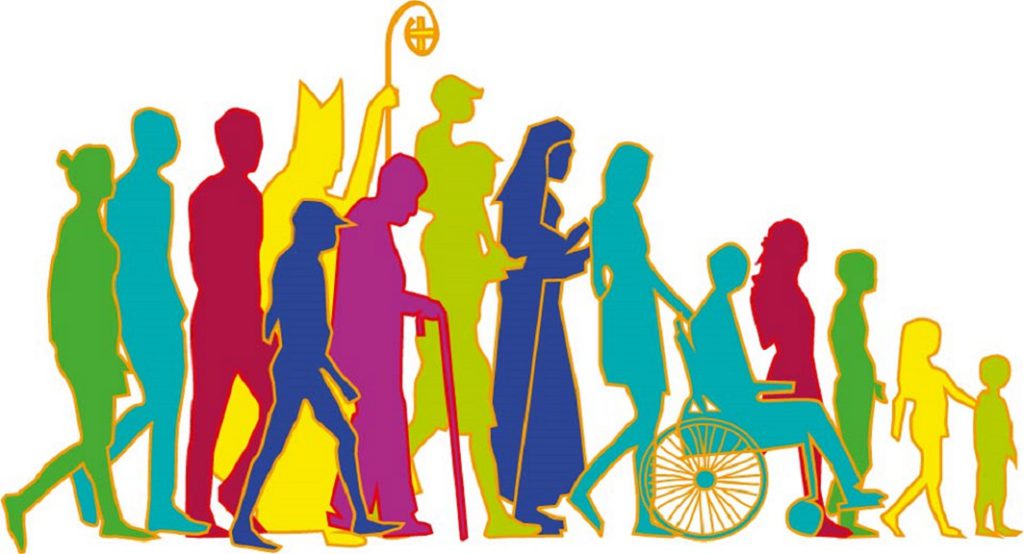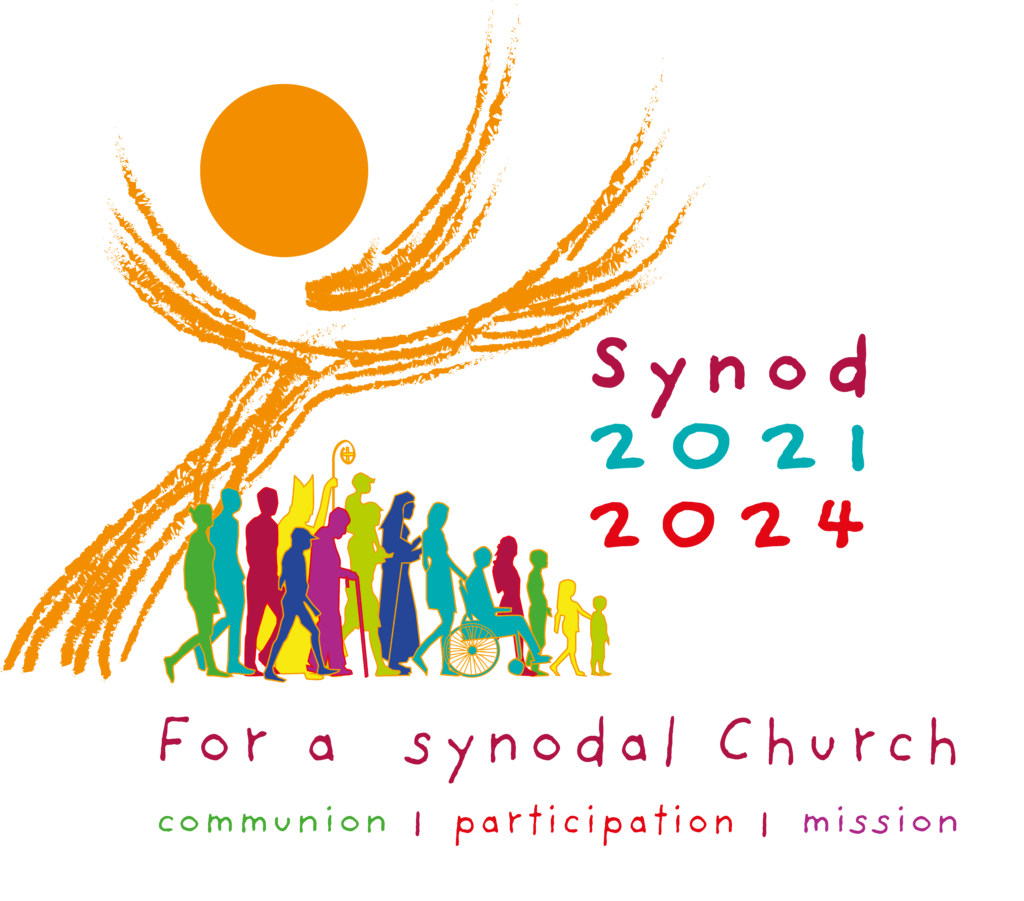
Synthesis Report on Hallam Diocese Synodal Journey
You can download a pdf version of the Synthesis here:
You can download a pdf version of the summary document here:
National Synthesis Report – England and Wales
You can read and download a pdf version of the National Synthesis document following this link:
Working Document for The Continental Stage
You can access the working document for the continental stage here or download a pdf version below.
Synthesis-Report of the XVI Ordinary General Assembly of the Synod of Bishops
You can read the final document of the synod meeting which took place in Rome during October 2023
Synthesis Report on Hallam Diocese Synodal Journey
April 2022

Executive summary
People from 60% of active Catholic parishes in the Diocese of Hallam responded to a call to reflect together on their communion with, participation in and mission for and with the Church. The outcome of this 5 month process is a picture of a beloved Church in need of some reforms to enable that communion, participation and mission to go on into the future. There are many ideas about what can be done to create a more welcoming and inclusive Church that speaks, listens and lives the Gospel. Some suggestions for change are for the Universal Church, some changes can be carried forward at Diocesan and Parish level. The synodal process was seen as positive and hopeful and there was a wish for good fruits to come from it. A Synodal Review Meeting is scheduled for March 2023 to review the progress in the Diocese.
Acknowledgements
Thanks, and appreciation to all who have contributed their time, love and skills to bring this report to completion, on time.Special thanks to our three consultants who gave pro bono.
And to the Core Group who spent many days on the analysis of the feedback from individuals and parishes.
And to the Parish Representatives who shepherded their parishes and groups through the Synodal journey.
And to parish priests who facilitated and contributed to the process.
And to all the people of God who journey with us.
Grace and Peace
Introduction
“A Synodal Church, in announcing the Gospel, “journeys together”. How is this ‘journeying together’ happening today in your church?
What steps does the Spirit invite us to take in order to grow in our “journeying together?”(PD26)
In October 2021 Pope Francis convoked a Synod on Synodality, asking that the first phase be a process of encounter, listening and discerning with all people of good will.
This report provides a summary of the processes and outcomes, and the highs and lows of inviting the people of the Diocese of Hallam to reflect on the question Pope Francis asks.
1 About the Diocese (Appendix A)
The Diocese of Hallam consists of 52 parishes (60 churches) amidst an approximate population of 1.6 million. The Mass-going attendance on pre-covid figures (2019) was 10,311 (0.006% of the population), and for 2020 (in early stages of lifting of some Covid restrictions) was 3633 (0.002% of the population).
There are 34 Priests in active ministry in the Diocese plus 2 assistant priests. 24 priests have responsibility for more than one Mass Centre (i.e. additional parish or Chapel of Ease).
There are 14 deacons in active ministry although only eight parishes indicated that they had a deacon. 20 parishes indicated that they have a pastoral council.
About 60% of parishes engaged with the synodal process in a variety of ways.
2. The Synodal Process
2.1 Who? (Appendix B)
The synodal process was led by the Bishop and Vicar General, with two Formation and Mission Coordinators, 12 volunteers providing the Core Steering Group, a Working Group of 2 volunteer representatives from each parish, and representatives from other groups.
2.2 How many parishioners were involved? (Appendix C)
46% of total post-covid Mass attenders were involved, or 16% of pre-Covid Mass attenders. Responses came from parishes right across the diocese except for one area. (Appendix C, Figure 1) 79% of these were practicing Catholics, 7% had left the church. (Appendix C, Figure 2). 75% were aged over 55 but there was also a small but wide range of respondents of different ages. (Appendix C, Figure 3)
3 Learning and Communicating
3.1 Learning about synodality (Appendix D)
It was necessary for all the people of God to learn the meaning of the word ‘synodality,’ in order to understand Pope Francis’ purpose in asking for this consultation phase. Documents from the Vatican, “Vademecum” and “Preparatory Document” were read, discussed and advertised particularly to parish representatives, and on the Diocesan website. Collection and processing of the data gathered with aspects of civic consultations were considered. Practical skills of active listening were addressed in early meetings of the Working Group, and reflected on in the group meetings.
As would be expected, many of the volunteers were skilled and experienced in working with groups and listening to others, but even so, some noted with surprise and delight that the experience of attending to their own listening in the small synod groups was enlightening for them as the ‘listening deeply’ helped them to hear what they might otherwise have missed and the experience spread to other parts of their lives.
3.2 Learning about discernment
Having gathered together and listened, people recognised that next step was to discern the prompting of the Holy Spirit.Discernment seemed to be a potentially fruitful stumbling block, because when people became aware of the challenge of discernment, they wanted to learn more about it, recognized it needed more time, and it has become one of the strands to take forward into the next phase of the synodal process. Looking to the future will require a discernment process across the diocese and perhaps the formulation of e.g. Diocesan Pastoral Plan.
3.3 Communicating (Appendix E)
As parishioners have differing interests in and access to different forms of communication, e.g. email, social media, traditional print media, internet, the Parish Newsletter was the obvious and established route for communication. However, relying on this was not unproblematic, as its availability for synodal communications from the diocese or from synod representatives, relied on a co-operative parish priest or newsletter producer. This was not always the case. Some parishes had only infrequent newsletters, some had not returned to having newsletters post-pandemic, some only had them online. It was not as reliable a means of wide communication as might be expected.
Prayer was important in different ways to all aspects of communications. For example, nothing was communicated without a period of prayer to discern whether the voice being communicated was that of the Holy Spirit. This was a challenging and interesting step in the synodal journey which took time and learning.
3.4 What was communicated and what were the difficulties? (Appendix F)
Communications were to provide answers to frequently asked questions of ‘What is a synod’, ‘What is Pope Francis asking?’ and “How can I get involved with the parish, the diocese and the universal church in this process?”
Difficulties of timing and resources. The timing of our diocesan synod process limited opportunities for publicizing the synod. Engagement of those who could be described as ‘on the margins’ needed to be part of a wider involvement in order to be respectful and meaningful. Where it did take place it was welcomed. However, this reinforced the idea of the synod as an ongoing process as the journey could continue, to involve and hear more from the marginalized and plan how to promote further openness and involvement. Reflections on the process acknowledged this, and some parishes were ready to continue the next phase of the synodality in the parish to include those efforts. A Diocesan Synod Review Meeting is scheduled for March 2023 to encourage continuing involvement.
4 Spirituality, prayer, discernment and synodality
Every meeting began with the ‘Adsumus Sancte Spiritus’, the prayer to the Holy Spirit from the Second Vatican Council.
Each meeting followed the structure which, as well as addressing practical matters, included a Scripture Reading, usually from the Mass reading of the day, followed by a period of reflection and sharing. There was a deliberate emphasis on attending to the movement of the Holy Spirit in the group who were meeting. People commented that they had learned from the experience of attending the groups to pay more attention to the movement of the Spirit in their everyday lives; this appears to be part of the learning of the synodal journey.
The whole process began with a pastoral letter from Bishop Ralph followed by a joyful liturgy in October 2021 at the Cathedral Church of the Diocese. This diocesan phase ended five months later with a quieter, more informal time of shared prayer, Scripture and reflection at the Pre-Synod Meeting, in March 2022.
Prayer was integral to the work, and to the process. Some participants commented that it had seemed unusual and a bit awkward for them at first, to be sharing their prayerful reflections, but that they had come to enjoy both the time of prayer, the opportunity to reflect, and sharing their own and other people reflections. Similar feedback came from other synodal meetings which introduced the same structure; people valued the opportunity to share their faith and continuing with such opportunities was one of the requests to the diocese going forward in the synodal journey.
5 Getting involved on the synodal journey

Over 400 individuals took part in the synodal process. There were over 1,200 responses across the four different engagement methodologies.
5.1 Dear Pope Francis Postcards
People who felt that their voice would be lost in the process of passing on information to the Bishop’s Conference were reassured by the clear invitation from the Vatican Synod Office that individual responses could be sent directly to Rome. While a series of Synodal Listening “Focus” Groups were made available by some parishes, and an open meeting in each Deanery was also arranged, alternatives were offered in the form of the postcards preaddressed to Pope Francis and a paper and on-line survey
5.2 Paper/Digital Survey (Appendix F)
Some people wanted to be involved in the synodal process but for various reasons were unable to attend listening group sessions. In order to create a pathway for these people to be involved, a diocesan survey was made available for all parishes, on-line and distributed to churches. This provided a wealth of interesting information about the views of the people of God.
5.3 Focus Groups
Some pre-existing groups used their time and relationships to have synodal meetings and conveyed a summary of their discussions to the Core Group, e.g. walking groups, book club, prayer group, Children’s liturgy, SVP.
5.4 Parish Synodal Listening
Some parishes undertook synodal listening group meetings. One parish organized a half-day meeting. The responses from these were gathered by the parish representatives and passed on as Parish Responses to the Synod Core Group for synthesis or sent separately to Synod Leads.
6 Responses that were significant, surprising, unexpected, joys, positives, strongly repeated resonance, mentioned less often but interesting and noteworthy
6.1 Describing the Catholic Church
Survey respondents were asked for three words to describe the Church.

Some aspects of the picture of the church that emerges are not surprising, but what is perhaps surprising is the mixed feelings that the church evokes. It is described as both rigid and friendly, spiritual and restrictive, supportive and hypocritical. Many of the larger (i.e., more frequent) words are associated with the ‘outdated’, ‘archaic’, ‘homophobic’, ‘conservative’, ‘traditional’ and ‘hierarchical’. The largest words are ‘community’ and ‘universal’. It might be interesting for parishes to imagine what words Catholics would like to be the most common ways of describing the Catholic Church.
Some words also convey an idea of the church as an institution. There are some hints of a more mystical perspective, the church seen as the ‘people of God’, ‘Body of Christ’, ‘sacramental’, ‘love’, ‘holy’. Remembering that 75% of these responses were from practicing Catholics, we can begin to get a sense of the ambivalence that emerges strongly in other questions and in the listening groups, as committed Catholics think about their journeying with a beloved church that means a great deal while they also disagree, and strongly, with aspects of it and want change.
Other individual responses to survey questions and summaries from parishes of the results of their group discussions and surveys were combined. The Working Group divided responses into themes, working in pairs or larger groups, in order to discern a common understanding and agreement as to the definition and meaning of the themes.
It was surprising and interesting to note that the majority of these responses were concerns grounded in the theology and teachings of Vatican II. Sixty years later, the people were claiming their authority to speak as the People of God by virtue of their baptism. Many commented that they were pleased to be asked as they had never been asked before. But there was also reference to the Church as something that was an institution and separate from themselves. This feeling conveyed helplessness, passivity and lack of voice in a hierarchical, distant, institutional church; this emerged from different perspectives, themes, discussions and responses.
6.2 Themes that emerged from the engagement of the people
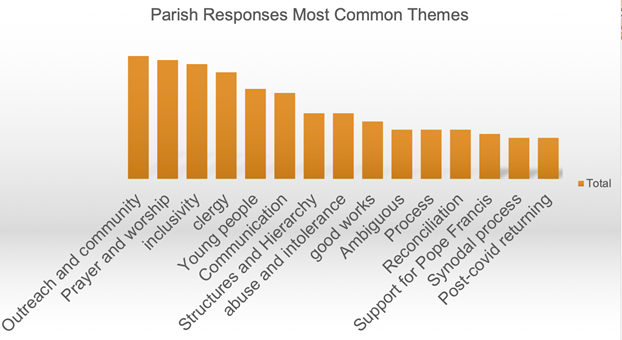
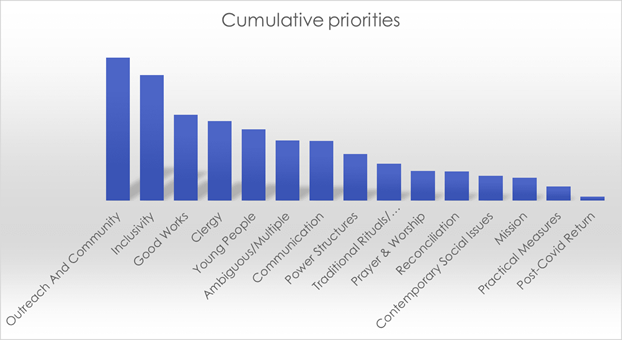
An analysis of the responses from all the methods used resulted in the themes listed in Fig. 6 and 7, described below:
Outreach, Community and Mission
This theme reflected the desire to be an outward-looking, inclusive community, welcoming others in and helping those in need (local and abroad), as well as being part of the wider Catholic Church. Being more involved in the local community was often mentioned as was offering social events to build (re-build) the community post-Covid, and not just coming to Mass. Groups who might need extra effort, the lonely, single people, mothers and babies were mentioned. Youth groups and Catholic young adult social events were also suggested. ‘Mission’ was mentioned specifically by some, along with Good Works. “Catholicism should be accessible to all, not just in church”…”nurturing the community”.
Prayer and worship
Responses in this category were moving and heartfelt, as people described their faith as “Centre of my life” and described also the call to holiness: “I feel the Holy Spirit is asking me to develop a much greater love, knowledge and understanding of Scripture.”
The joy of going through sacraments with others, children, grandchildren, along with ‘shared beliefs’ and “a community of like-minded people” were all mentioned but it was clear that views of practicing Catholics differ greatly. Some people cannot tolerate any more involvement in the Church and said they have had to walk away and others, apparently holding similar views, are able to suspend their criticisms most of the time and still find some spiritual comfort and nourishment in coming to Church.
A few suggested the parish should be more full of “Happiness and joyfulness.” “We are a dismal church, closer to purgatory than heaven, we should be more outward looking”
People talked in very real terms about their relationship with God, e.g. being angry with God. There was a generous acknowledgement that different people appreciated the liturgy differently and that there is room for different ways of praying. Music was felt to be a possible way to encourage young people to stay involved and of being inclusive to different cultures.
Others suggested the Church should be more missionary, explain the Mass more, help different people to find a role, for example, single people getting overlooked as a group. Some people regretted the old days when the church was a more tight-knit community. There were specific concerns e.g. for a new sound system, for disabled parking, for priests to speak loudly and clearly for the benefit of those who had difficulty hearing, and a request to make sure the church is warm enough. People said it was nice to have the choice of different types of liturgies, from the quiet to the songful. One person invoked the blessing of her favourite, St Anthony. One concern was from a person who said that the sacrament of reconciliation should be done to respect the anonymity and privacy of the penitent, which may be a response to some of the Covid arrangements for Reconciliation. Access to the Sacraments was mentioned, particularly in relation to ‘due reverence’ at Mass, the loss of Sacramental opportunities during lockdown and the looming shortage of priests.
Inclusivity
Inclusivity was a large and broad category into which was assigned all mentions of issues to do with Church teaching and behavior which did not afford equality to various groups. The language of equality somewhat masks the underlying pain, sadness and deep feeling caused by the restrictions which lead to the call for equality. Equal opportunities for women in all roles in the church organization, as well as ordination, was the most frequently mentioned, to the extent that in the final synodal meeting it was felt strongly by some that this should be a separate category to acknowledge the significant weight of feeling behind this view although this wasn’t possible due to time constraints. There was dissatisfaction with the lack of equality of opportunity for the laity to share in collaborative ministry. There were suggestions that there should be more ecumenical effort and development of relationships with other faiths. Divorced and remarried expressed great hurt at their exclusion. LGBTQA+ were specified as a group who were particularly excluded by the church and all who mentioned this wanted things to change. Other suggestions for a more inclusive church were for access for other disabilities such as deaf and blind. Wheelchair access was greatly appreciated as were translations. A group for men and for different age groups was also mentioned. The church was seen as intolerant in practice and the aspiration was for an open, welcoming church. Inclusive communion was suggested by some, with particular regrets where a person couldn’t share communion with a non-Catholic Christian partner. Blessings for same-sex couples were also seen as ways of being more inclusive.
In some parishes the task of making the parish more welcoming was already being addressed as a direct result of the synodal conversations. It was noted that different Mass times tended to create their own communities, and made recommendations for occasional social events for the different groups. The strength of feeling about the misogyny and inequality in the treatment of women also led to the appeal to ‘ressourcement’, the searching out of previously held truths from earlier times of the churches mission.
“Give women access to roles in the modern church that they had in the early church”.
Clergy
Parishioners from across the diocese were appreciative of the charisms, pastoral work, commitment, and hard work of their parish priest. Some parishes with deacons seemed to be more aware of the role of the deacon. Some expressed concern at the well-being of isolated, elderly and overworked priests, and concern about the decline in numbers of priests and what this means for their future access to sacraments. All were very grateful for the efforts made by priests to ensure mass was available online although one felt the priests should have fought for churches to remain open as essential services and was angry with the church’s compliance to government on church closure.
There were some (many fewer) critical comments about relationships with clergy. These seemed to be related to questions of authority; clericalism, who makes decisions about what happens in the parish and ‘infantalising the laity’ were mentioned. Some responses were from the point of view that the priest held authority by virtue of ordination, others saw the role more as servant leader needing to work in collaboration with laity. The excessive workload of priests was suggested as an explanation for some of the tensions. Examples of disrespectful behavior between priest and laity were given, perhaps expressing something about expectations, perceptions and understanding of each other’s role as well as reactions to difficult Diocesan decisions about parish closures.
Some laity felt unable to fully express their own ‘baptised prophet, priest and king’ role and one expressed this by quoting Canon Law 212.3 “the Christian faithful have the right and even at times the duty to manifest to the sacred pastors their opinion on matters that obtain to the good of the Church and to make their opinion known.”
There was a concern that newly ordained priests often seemed to adhere to a model of clerical dominance. Clergy selection, formation and ongoing training was mentioned as in need of improvement such as involving laity in recruitment, updating what is taught and spending less time in seminary.
People suggested that married men and optional celibacy would enable the priesthood to be enriched in many ways as well as address the shortage of priests.
Allowing women to be ordained into the priesthood, was mentioned by very many, in all 4 engagement methods.
Where it was mentioned, the contribution of Deacons was mentioned warmly, as providing an enormous service to the parish. It was suggested that the wife of one Deacon provided the sort of service to the parish which could be seen in the women deacons of the early Christian communities, and there was a request for women deacons to be introduced.
Young people
Young people wanted to feel their voices are being heard by the church and that they could take more part in the Mass. They wanted the Church to be more encouraging and inviting, with more Christian social events. Young people expressed that there were put off by the attitude to women in the church, they want this to be more inclusive. Speaking of themselves, young people said they don’t see the equality and inclusion of women as even an issue. Speaking about young people, other adults expressed real “concerns over passing on of our faith to our children.” And this was a source of pain and sadness, particularly for grandparents. It was suggested that the young people should be asked: “The church should ask the children what they want out of their community and what they can give.” Sessions for young people to keep their relationship with God were suggested. Encouraging young people back to the church was popular and uncontentious. The suggestion of a diocesan provision of deanery youth workers was made.
Abuse, intolerance and reconciliation
The pain, shame, sadness, anger created and ongoing due to the clerical abuse scandals of the Catholic Church were mentioned many times. Ongoing reconciliation and atonement were seen as necessary now and into the future. Nobody acknowledged the safeguarding now in place, one person said being believed was important, and ‘abuse’ referred to the broad range of sexual, physical, emotional and spiritual abuse. The issue was generally referred to as ‘the abuse scandal’ and the lack of words or language for this suggests the process of assimilating the evil tragedy of what has happened to the church is only at the beginning.
Communication
The category of communication includes a range of dissatisfactions and plenty of suggestions of how to improve things, from church language being exclusive, old-fashioned and inaccessible, to the need for the diocese and parish priests to communicate more effectively, internally and externally, including better PR about the good works the Church does. It was noted that that the synodal experience made it apparent that many Catholics were unfamiliar with the experience of talking about their faith and lack the language and the vocabulary. Modernizing the communication strategy of the diocese with more use of social media and better advertising of the work of the diocese and formation opportunities was suggested. This connected with the idea of the laity becoming more educated about their faith and contributing more to the liturgy, including offering homilies. Under this category, ecumenism was a feature, as people suggested that church ought to be more outward looking and working alongside other denominations and faiths.
Good works
Involvement in social justice issues was seen generally as an integral part of what it means to be Catholic, following Jesus’ admonitions to feed the hungry, visit the sick and the prisoner, and provide comfort and shelter for refugees. Some people wanted the church to make more of the good works that were done, to counterbalance the negative views of church from recent abuse scandals. Others wanted pastoral care and visits, especially for the old and lonely. Some spoke warmly of the care they had received, if only virtually, during the lonely times of Covid. Only a few responses referred to the call to care for the environment, which might seem somewhat surprising or just that more work needs to be done to help people to be more aware of Laudato Si and that aspect of the call to holiness. One person spoke against too much emphasis on good works.
Pope Francis
Many people expressed love, appreciation and gratitude to Pope Francis. The “Dear Pope Francis” postcards which were provided for people to make an individual response were predominately messages of encouragement and appreciation for the opportunity. (Some people may have sent these straight to Rome; any that were sent to the diocesan synod were scanned and sent to Rome).
One asked for tolerance toward the Latin Mass, and another expressed anxiety about freedom of religion being maintained in other countries. Some urged him to stay strong in the face of opposition to his reforms to the curia.
Post-covid returning to collective in-person worship
Much of the synod encounters in the diocese was done in the period of time when the country was gradually emerging form the restrictions of the Covid pandemic. This emerged in the expressions of concern and appreciation as people rejoiced in returning to Mass. They also acknowledged with deep gratitude the “wonderful gift of being able to watch and participate in Mass online,” “Online social meetings after mass”, “the welcoming rota”. Some reflected on how the lockdown had made them appreciate Mass, their social contacts, the small things and their faith; ‘God was the only one I could turn to’. More than one person remarked that we took many things for granted before the pandemic. Two people reported they had re-found their faith during the pandemic, and others that they had prayed together more as a family.
Power, Structures and hierarchy
There was some distress and evidence of old hurts in discussions about the hierarchy and structures of the Church. The behavior of the hierarchy, secrecy, and protecting reputations, abusing power, and patronizing the laity are deep pastoral wounds. There was a clear worry about the lottery of how collaborative, pastoral and available a new priest was to the parish. Regular reviews of priest’s performance, good practice, training, and development needs was suggested as a necessary way forward. Experiences with a Diocesan structure seen to be distant and unresponsive led to suggestions for improvements in communication strategies from the diocese and a Diocesan Pastoral Council with laity representatives, so parishes have a voice in discussions and decisions. Involving women at all levels of decision-making in the Church was advocated, along with a review of Canon Law.
Spectrum of ‘Traditional conservative Catholic’ to ‘Progressive liberal Catholic’
A large proportion of respondents advocated, described, and suggested ‘Change and Modernization’, in every aspect of the Church life, from Canon Law (to make it “more aligned to International Human Rights Legislation, advances in science and modern life”), attitudes to sexuality, (“the churches attitude to sexuality and homosexuality is outdated”), to women, role of the laity, use of social media, to priestly formation and optional celibacy. Taking a more Christian view of the modern world was advocated, as was a plea for a “simpler church more firmly grounded in the essence of the Gospel message.” The outdated views of church was seen as responsible for the absence of young people for whom inclusivity is taken for granted.
A very few people expressed antipathy to change, asking for no change, for a holding onto or return to familiar traditions, seeing change as a ‘watering down of the faith’. Sadness and anger about lack of availability of the Latin mass was expressed by a few, who also seemed to feel their views would not be allowed to be expressed while seeming to be aware that the majority view is for change.
The value of traditional forms of prayer and worship and the rhythm of the liturgical year were mentioned as important aspects for many people’s faith journey, as well as availability of pious groups such as Legion of Mary. There was a shared love of the faith and the sacraments by both ends of this spectrum of Catholicism, although differing views about what they liked about liturgy.
Ambiguous/multiple
This category contained anything else that was not clearly located elsewhere, such as Education, ‘Love each other’, supporting and helping one another, and how ‘Jesus should impact on everyday life separate from religion’.
7 Synod process
Many, many people reported that they were pleased and surprised to be invited to have the opportunity to speak and be listened to. They clearly enjoyed the parish synod listening meetings; many found the synodal listening groups “wonderful, you could talk about anything”.
One person pointed out that having ‘synod meetings’ was helpful in providing a reason and purpose in having more meetings and the consequent building up of community. There was great depth of feeling of anger, betrayal, and hurt expressed about the abuses of the church. There was also great joy and gratitude, identifying the process as “spirit-filled”. One person felt there should have been more time spent on prayer.
There was some fear and pessimism that a watered-down version of people’s concerns would be presented to the CBCEW and people were very pleased throughout the process to see the Bishop joining many meetings and being present at the final summary meeting. People also expressed the wish that the synodal process would continue, and parishes, the diocese and the universal church would take account of what they have learned.
For the Synod Working Group, being engaged in the process and hearing from so many in great depth and fervor about the importance of their faith was a humbling and privileged experience. It was seen as a spirit-filled experience, which “allowed the space for the blessings of each other to fall on us all.”
It was also surprising and unexpected to hear people expressing views which were often different from expectations.
8 Next Steps
“This first phase of the synodal journey is to foster a broad common experience of lived synodality”(V 1.5). A strong emphasis from the outset has been on the importance of the synodal process. This report provides a good overview of the range of experiences of journeying with church. As the synodal process continues in parishes and in the diocese over the next 12 months, parishes and groups may wish to discern, from the challenges and opportunities which arise from listening to the concerns and ideas raised, what their local steps might be. A Synod Review Meeting is planned for March 2023.
9 Summary and Conclusion
The strongest themes from all aspects of the journeying together in Hallam at this time seem to be:
- Inclusivity
- Community, Outreach and mission
- Clergy
- Young People
- Good works
Members of this engaged Catholic community want to see the Church (local and global) thrive into the future; there is concern that the Church faces existential problems and there is a need for concerted collaboration and new ways of journeying together.
People feel there is an opportunity to change, grow and thrive with continued engagement building on the Synodal process. Discernment needs time. If the first step of the synodal process is the gathering of the information which is necessary for following a discernment cycle of ‘recognising’, ‘interpreting’ and ‘choosing’, with the eyes of the disciple, for the Kingdom, then there is a larger, more focused, diocesan-wide discernment process which is yet to be engaged in. Many of the concerns can only be addressed by the Universal Catholic Church. Many more can be the day-to-day business of diocese, clergy and people at local level. As the results of the listening are shared widely, the call and movement into action will be the fruits of that wider discernment.
The synodal process itself was life-giving, allowing space for ‘blessings of each other to fall on us all.’ The strength and depth of feelings, positive and negative, were conveyed very strongly and movingly in the responses to surveys and in listening encounters. It clearly was seen as a Spirit-led process for moving onward as church, and prayers for this were asked for and continue.
APPENDICES
Appendix A: About the Diocese
- Area covered and number of parishes
The Diocese of Hallam was formed on 30 May 1980 from the division of the Dioceses of Leeds and Nottingham. It consists of 52 parishes (60 churches) in the county of South Yorkshire, parts of the High Peak and Chesterfield Districts of Derbyshire, and the district of Bassetlaw in Nottinghamshire. The administrative arrangement for the diocese is by division into 5 Deaneries which are generally co-terminus the political organization of the Metropolitan Borough and City of Sheffield (population approx.. 585,000), Metropolitan borough of Barnsley (pop. 247,000), Rotherham Metropolitan Borough (110,000), Metropolitan Borough of Doncaster (population 110,000), and the Chesterfield Deanery which comprises Chesterfield Borough (population 88,500), part of the High Peak District (population 92,000) and the Bassetlaw District (104,000), an approximate population of 1.6 million.
- Population
The Mass-going attendance on pre-covid figures (2019) was 10,311 (0.006% of the population), and for 2020 (in early stages of lifting of some Covid restrictions) was 3633 (0.002% of the population).
- Mass attendance
Mass attendance for 2020 averaged 3633, which covers the period of lockdown during the pandemic. (2019: 10,311).
- Number and Age of Priests
There are 34 Priests in active ministry in the Diocese including 16 from outside the Diocese, plus 2 assistant priests.
16 priests have responsibility for more than one parish. 24 priests have responsibility for more than one Mass Centre (i.e. additional parish or Chapel of Ease).
Of the 18 Diocesan priests, four are above the canonical retirement age (75) and two are under 40. Six will have reached the canonical retirement age within the next ten years. There are two seminarians. There are two priests who belong to the Polish Catholic Mission. One of the diocesan priests has additional responsibility for ministry to the Slovak Community. There is one retired Jesuit who ministers to a Jesuit School.
- Deacons
There are 14 deacons in active ministry. However only eight parishes indicated that they had a deacon.
- Pastoral Council
20 parishes indicated that they have a pastoral council although one was suspended due to Covid. Lay people and priests sometimes differed in their opinion about whether the parish had a pastoral council.
- Religious houses
There are 7 houses of religious women and approximately 30 religious sisters, although these did not make a separate response.
- Parishes involved in synodal journey
About 60% of parishes engaged with the synodal process and submitted responses in a variety of forms. One recently suppressed deanery did not make any parish returns to the process although a few individuals from within that area did respond. The Polish Catholic Mission did not contribute to the diocesan phase.
- Number of people involved
Approximately 1667 people became actively involved in the process (although this might include some participants being counted twice, as some people may have filled in a survey and also been involved in parish meetings.)
Appendix B: Synod process, who and what
The Bishop, the Vicar General, Synod Leads, Synod Working Group, Core Group and Consultants
Bishop Ralph Heskett and Mgr Desmond Sexton (Vicar General) oversaw the process through regular meetings with Synod Leads and attending synodal listening meetings.
Synod Leads: Fionnuala Frances and Kevan Grady were invited by Bishop Ralph to take on the role of synod leads. Both are long-standing members of the diocese and recently appointed to the 3 day/week shared role of Formation and Mission Coordinators.
One of the joys of the process was that these recent appointees were able to focus on the Synod. The Synod Leads had to work in a synodal way together, developing collaborative working, sharing ideas, praying and discerning about the process and what they were being called on to do by the Holy Spirit. Neither were neutral about the task, but spent time sharing and acknowledging their own perspectives, taking necessary steps to try to identify and manage implicit bias.
Synod Working Group: Through parish newsletters, each parish was invited to nominate two representatives, a man and a woman, to lead their local process. Representatives of any other parish groups were also invited to join e.g. SVP, women religious.
This invitation brought together an interesting, thoughtful, committed group of parishioners from across the diocese who benefitted from and enjoyed the task of listening and working together, where this was successful. There were some examples of where this wasn’t quite so successful, because of course the difficulties that can arise in human relationships can arise in synodal encounters also. Interestingly, the limited time available for the task was helpful here as it was for the synodal encounter groups. Having to speak succinctly about what is one’s foremost concern, leaving space for reflection for the Holy Spirit, led to a way of living with differences which allowed the work to continue fruitfully.
Clergy chose whether and how to participate. Some priests and deacons were part of the parish groups, some didn’t want to intrude on space for the laity. There were mixed views about this from both clergy and laity, some people expressing disappointment that the priests weren’t hearing what was being said. There were separate Synod Group meetings arranged for priests and for deacons.
Core Group: 12 people volunteered to be part of the Core Group steering the project, meeting regularly with Synod Leads and eventually becoming involved in the processing of the responses from parishes and individual surveys. This smaller group were a talented and wise group who took their responsibilities very seriously. They were involved in their parish synodal process to varying degrees.
External advisors: A professional researcher, Dr Felicity Heathcote-Marcz, was recruited to advice on the collection and processing of the data gathered throughout the consultation exercise. Prof. Matthew Flinders, Professor of Politics and specialist in innovations in public participation, advised on aspects of civic consultations. Fr Paul Nicholson SJ advised on Discernment.
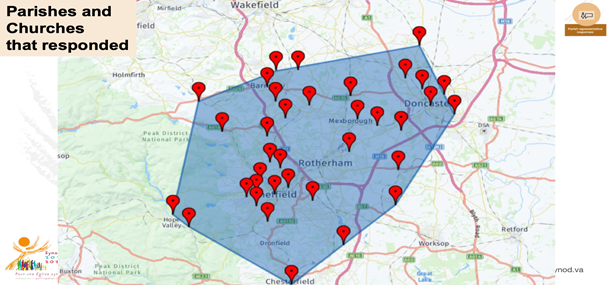
Appendix C: Diagrams showing the location of respondents, their age, their religious affiliation and relationship with the church.
Responses came from right across the diocese, with the exception of one parish, where there were individual returns. 75% respondents were Catholic, and two thirds were above 55.
Thus a reasonable number of people engaged in the process. As above, improving the range and number of those getting involved was a frequent discussion and suggested as an important aim for the synodal process going forward. The success of such a focus would also be quickly assessed from the important information gathered.
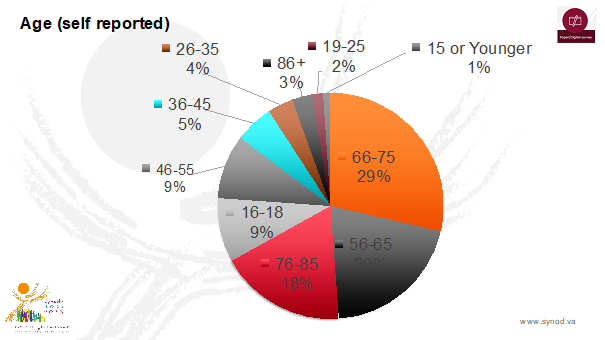
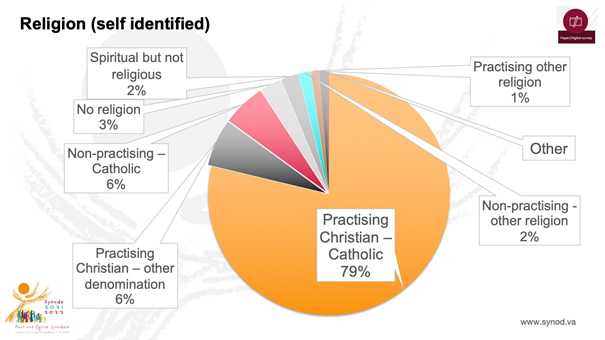
More than three quarters who responded to the survey individually or on-line identified themselves as practicing Catholics.
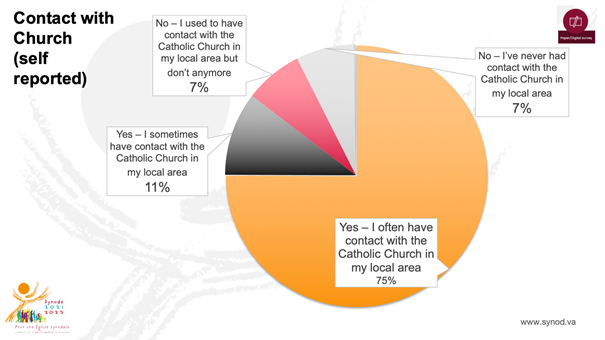
7% of those who responded no longer had contact with the Church. This is a group who are of interest and concern to those who remain in the Church.
Appendix D: Learning about Synodality
Training events attended and delivered
- Reading and publicizing the Vatican Vadamecum and Preparatory Documents.
- Attended and publicized various training events:
- ‘Synodality’ at Margaret Beaufort Institute; at Roehampton Institute;
- ‘Theological Action Research’ at Roehampton Institute;
- Lecture ‘Pope Francis’ vision for the synod of Bishops’, NCR, Bishop McElroy;
- Meetings of Diocesan Synod Leads organized by CBCEW;
- Westminster Diocese conference on ‘The Synodal Path’;
- Consultation with Carmelite sisters on Synodality (which is part of their charism and practice); Attended “Root and Branch lay-led synod”, Bristol’
- Organized webinar on “How to hold Public Consultations” with Prof Matthew Flinders;
- Organized series of training meetings “How to Do Discernment” with Fr Paul Nicolson SJ;
- Organized and attended “Vatican II and the Links to Synodality” with Dr Greg Ryan from Durham University Theology department.
- Attended Austin Ivereigh’s symposium at Campion Hall on “Synodality”, speakers included Cardinal Grech and Fr Giacomo Costa, both of whom contribute to the work of the Vatican Synod Office.
Resources made available on Diocesan Website
- “Hallam Synod smaller steps” Leaflet to help synodal conversations
- Posters for parishes
- Synod Response Record Sheets, individual, group, parish
- Safeguarding resources
- Resources developed by an individual parish and made available to other parishes
- Resources developed by other dioceses and kindly made available by them, in particular Motherwell Diocese, Northampton and Westminster Diocese.
Appendix E: Communication methods and materials
How information about the synodal process was communicated.
Methods
- Emails to parish priests for updating information about the project, and for inserting notices into
- Parish newsletters, (via priest or local arrangements)
- The diocesan newspaper, Hallam News
- A Twitter account was opened, Synod@Hallam,
- Diocesan website; a newsletter and dedicated Synod section was established, with links to the Vatican synod documents and to which were added other resources shared from other diocese
- Some parishes provided copies of the synod documents in larger print.
- Support from CBCEW: Meeting (on zoom) of all diocesan leads with Canon Christopher Thomas, General Secretary of CBCEW, and ongoing email contact with Canon Thomas.
- Meetings with parish representatives, on zoom, with regular drop-in sessions for help and support and troubleshooting during the parish data gathering phase
- Face to face meetings, scheduled as required, with key stakeholders
- Regular meetings with Bishop Ralph Heskett
Communication materials
- A Pastoral Letter from Bishop Ralph announced the process and invited the diocese to the opening liturgy (See Appendix G)
- Regular articles appeared in the monthly diocesan paper, Hallam News, updating on progress of synod and providing stories about the process to encourage people to stay or to get engaged.
- An article appeared in the Sheffield local newspaper, explaining the initiative to the wider public.
- Regular emails were sent to all priests, explaining and updating on the process, including inviting nomination of 2 representatives, invitations to zoom information meetings and to diocesan-wide events.
- Resources were listed and linked on diocesan website: How to have a synod meeting, record forms, Diocesan survey, ‘Dear Pope Francis’ postcards ^
- Invitation to diocesan-wide open synod meetings (offered in 3 of 5 deaneries to encourage accessibility).
- Calendar, with timetable of events; returns from parishes to be submitted by 7 March, leaving 3 weeks for pre-synod meeting 26 March, sharing results with the diocese prior to submission to CBCEW on 7 April.
- The draft report at pre-synod meeting, providing feedback on the outcome of the consultations and offering a final opportunity to ensure every voice was heard
- Promotional video of the closing Pre-Synodal event posted on website so available for those who were unable attend.
Appendix F. What Communication strategies?
- Our main communication strategy was the parish newsletter. It was somewhat disheartening to hear that some people did not feel they had heard anything about the synod, although the consultant, Prof. Flinders, had suggested from the outset that maximum participation would need a large investment in publicity and marketing, which wasn’t possible. Learning more about the synod required that people would become engaged with the idea, actively search for information and be computer literate. More public awareness was required to further involve those who did not attend or who no longer attended church.
- Covid restrictions, anxieties and safeguards varied from place to place and person to person across the diocese. Thus, Zoom meetings were regarded as most accessible, although alternatives were also offered. Few were attending Mass at the beginning, although, the variation was wide. Many groups were not yet meeting as they had been pre-Covid
- Some parishes had made additional arrangements with WhatsApp, telephone trees, mailshots to all on parish register, whereas some had no parish register. It was noticeable that where what might be called “synodal arrangements” were already established (parish register, regular contact with housebound, active parish groups), it was easier to introduce the synodal process. Going forward as synodal church, it will be helpful to notice the structures that were in place which made the synodal journey within a parish easier.
- Discussions took place among representatives and within parishes about who were the marginalized in their area. The elderly were identified as a potentially vulnerable group whose voices needed to be heard. Efforts were made in some parishes to visit and undertake synodal conversations with elderly and housebound parishioners. Efforts at involvement of prisoners, the homeless and refugees were not successful and are part of the discussions for future plans.
- Young people were regarded by some as being on the margins of the church and some efforts were made to ensure inclusion of young people, via schools and family groups, particularly during the Christmas period when older children may have been more available.
- The timing of our diocesan synod process limited opportunities for publicizing the synod. However, this reinforced the idea of the synod as an ongoing process as the journey could continue, to involve and hear more from the marginalized and plan how to promote further openness and involvement.
Appendix G: PASTORAL LETTER ON THE SYNOD / OCTOBER 2021
October 15, 2021
DIOCESE OF HALLAM
Pastoral Letter on the Synod.
In October 2018, I was privileged to be in Rome for the Synod on young people. It was the culmination of listening to young people in the Church from across the globe sharing their hopes and fears, joys and sorrow of being members of the Church. Their reflections formed the working document for the synod and a focus for further listening to the young people present during the synod itself. It was both an enriching and exhausting experience! A final document was drawn up reflecting all that we had heard during the days of the synod and a short while after the Holy Father responded to the young with an encouraging and challenging open letter, “Christus Vivit.”
Today, in Rome, the Holy Father will invite the whole Church to set out together on a new synodal journey. Once again, listening will be the method, discerning will be the aim, and participation will be the path.
The Holy Father asks that the theme of our shared journey be: Communion, Participation and Mission. The companion document for the journey (Vademecum) offers us these brief reflections to help us understand these key words for our journey.
Communion: “By his gracious will God gathers us together as diverse peoples of one faith through the covenant he offers his people……. Together we are inspired by listening to the Word of God, through the living Tradition of the Church and grounded in the sensus fidei that we share. We all have a role to play in discerning and living out God’s call for his people.”
Participation: “a call for the involvement of all who belong to the People of God -laity, consecrated and ordained – to engage in the exercise of deep and respectful listening to one another. The listening creates the space for us to hear the Holy Spirit together guides our aspirations for the Church for the Third Millennium. Participation is based on the fact that all the faithful are qualified and called to serve one another through the gifts they have each received through the Holy Spirit.”
Mission: The Church exists to evangelise. We can never be centred on ourselves. Our mission is to witness to the love of God in the midst of the whole human family.
The journey that we are about to set out on is not an exercise in gathering data and information or a series of meetings or debates. It is rather a prayerful process, rooted in a prayerful encounter with Jesus, reading of the scriptures, through the liturgical life of the Church and an openness to the movement of the Holy Spirit. At the heart of the process is the discernment of the way the Church is to be locally and worldwide at this moment in its history. Pope Francis makes this point about the synodal path in his book, “Let us Dream”:
“What is under discussion at synodal gatherings are not traditional truths of Christian doctrine. The Synod is concerned mainly with how this teaching can be lived and applied in the changing context of our times” P 84/85
We are invited to do this, by, first of all, listening to each other, but also by listening to our faith tradition and to the signs of the times in order to discern what God is saying to us and what his dream is for us.
Our response to the call of the Holy Father to journey together along the synodal path begins here in the diocese with an Opening Liturgy in the Cathedral at 4.30pm next Sunday 17 October. Throughout the autumn there will be an opportunity to meet at parish, deanery and diocesan level and engage in the synodal process of respectful listening to one another to our faith tradition and to the signs of the times. The fruits of our listening to one another will be collated and forwarded to Bishops Conference for the next step along the synodal path. For further details visit our diocesan website. www.hallam-diocese.com
As we prepare to set out on our journey, Pope Francis offers us this word of encouragement:
“Time belongs to the Lord. Trusting in Him, we move forward with courage, building unity through discernment, to discover and implement God’s dream for us and the paths of action ahead.” P94
+ Ralph Heskett CSsR
Bishop of Hallam
Appendix H: How did people get involved?
• Many people attended the Synod Opening Liturgy, and representatives took away a Synod Candle to bring back to their own parishes for use in synod listening meetings.
• Individual representatives then worked with their own parishes to choose how to journey further together, taking into account the demands and limitations of different contexts. The diocesan leads offered help as required (See Appendix D for list of resources made available in addition to those to be found on the Vatican resources website). No attempt was made to restrict the ways different parishes chose to take the process forward. Some parishes seemed to find this worryingly open-ended, some were quite happy with such a self-determining arrangement. The process in each parish in itself was enriching, and allowed the parish itself to discover the talents and willingness of people to become involved in whatever way they felt able. Thus one parish did not feel that their elderly parishioners were able to attend meetings in person nor were comfortable with zoom, so arranged visits.[1] Some arranged parish meetings, some designed their own survey based on their own adaptations of the Synodal question asked by Pope Francis, some used the diocesan survey, posted videos on parish website, signposted diocesan website resources in homilies, made themselves available to talk after mass, made home visits, watched and shared a video on ‘Discernment in the Everyday’ by Fr John Dardis SJ, attended or watched a presentation by Fr Paul Nicholson SJ on Discernment, (both on the diocesan website), encourage family members to engage in the process, emailed all parish groups, emailed all on parish database.
• Some parishes made documents available in church or hand delivered; one parish delivered the synod information and a local survey and invitation to meetings with a Christmas card (with Mass times) to each parishioner.
• Speaking after Mass to the congregation
• A Synodal post-box was provided at the back of church for any written responses to be returned.
• Survey on parish website
• Individual conversations with parish representatives.
• When responses were gathered, representatives were offered a Summary Response Form to complete which were returned to the Diocese Leads for collation and summarising.
• Some worked within existing structures, for example, holding an extra (unofficial) parish council meetings while others formed a special Synod Parish Team to plan, inviting parishioners to join.
• In addition to parish meetings, other groupings within parishes and across the diocese were invited to synod listening meetings, for example, parish book groups, SVP, UCM, Lectio Group, confirmation group, in person, on zoom,
• Priests of the Diocese in addition to being invited to participate in parish meetings, were invited to separate Synod meetings.
• Deacons of the Diocese, in addition to some being involved in parish meetings, held their own synodal encounter meeting
• School contacts were initiated via the school chaplains and meetings were arranged. Working with the newly appointed Director of Youth Ministry we provided opportunities for students to meet and respond to adapted versions of the synodal questions. The first meeting for KS3 took place over zoom. The second meeting for KS4 happened in person and KS5 were guided through the Diocesan survey in two schools with Sixth Forms.
• Prison chaplains were contacted and offered a shortened version of the diocesan survey for ease of use in their place of work. However, there was no response from this source in the time available.
• The Slovak language community were approached and separate sessions were arranged with this worshipping group.
• The director of St Wilfred’s Community Centre who work with homeless, excluded and vulnerable adults in Sheffield participated in the process but it was not possible to include any of their client group directly.
• All parishes were asked to reflect as part of their deliberations as to who were the marginalised in their area, as this was a particular emphasis of the invitation from Pope Francis. No other separate groupings emerged, and some parishes reported that previously meeting groups had not yet returned after Covid.
• One parish commented that the first parish meetings seemed to be expressions of concerns which suddenly had an outlet, while the second meetings were more likely to be looking forward to change and mission. This was not a deliberate model used by every parish but seems like a useful model of allowing space for discernment for the future.
Appendix J: Next Steps
One of the survey questions asked for the 3 priorities for the parish, diocese and universal church. Although there are some differences as to the greatest concerns in each area, the same themes came across. For the parish, inclusivity, community and outreach, good works and young people were the dominant concerns. For the diocese, people were most concerned for community and outreach, clergy, young people, and a category of general concerns. Priorities for the Universal Church were inclusivity, clergy, community and outreach and good works.
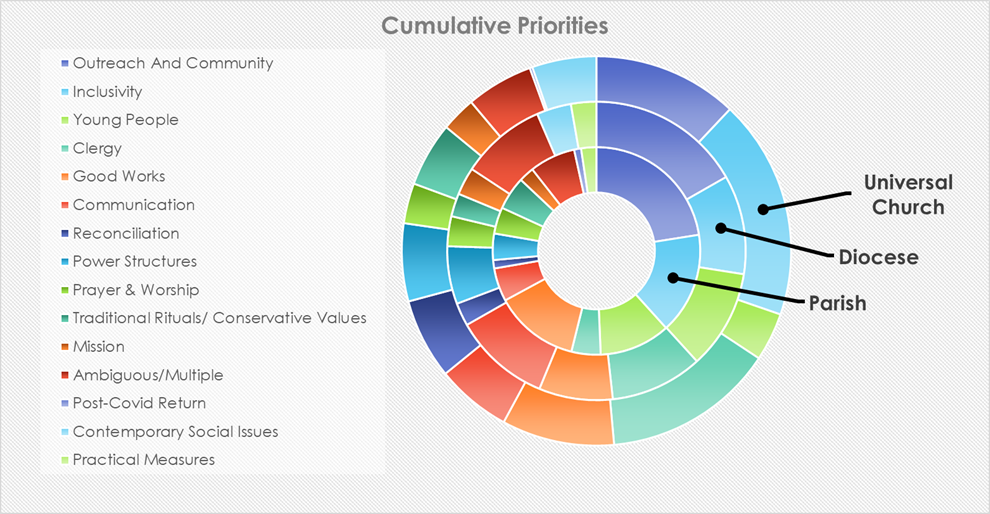
The final question, in many groups and in the survey, was to ask if there was anything else to say:
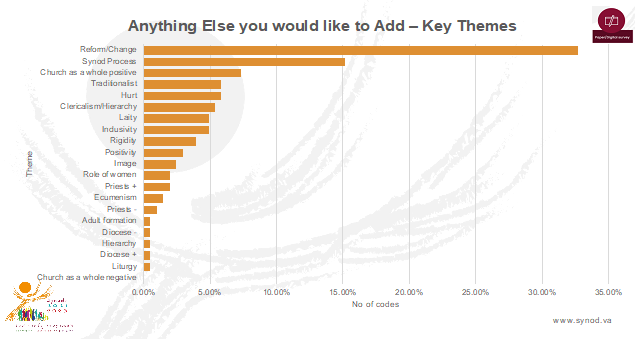
The response to the question about priorities, and ‘Anything else’ did not produce any new ideas, an indication that for now, for this process as conducted, a satisfactory endpoint had been reached.
References
“For a Synodal Church: Communion, Participation and Mission Vademecum. Official Handbook for Listening and Discerning. Published by Secretary General of the Synod of Bishops. www.vatican.va
“Synod 2023 Preparatory Document” www.vaticannews.va
Questions about this document can be addressed to:
or
Synod
Hallam Diocese Pastoral Centre
St Charles Street
Sheffield
S9 3WU
[1] One of the initial meetings of Parish Representatives was an information meeting on Safeguarding with the Diocesan Safeguarding Officer, to ensure everyone was aware of safeguarding issues and procedures for any diocesan volunteers. This was somewhat disturbing and unwelcome for some participants, although they understood the need for such precautions.
Synod Summary Report
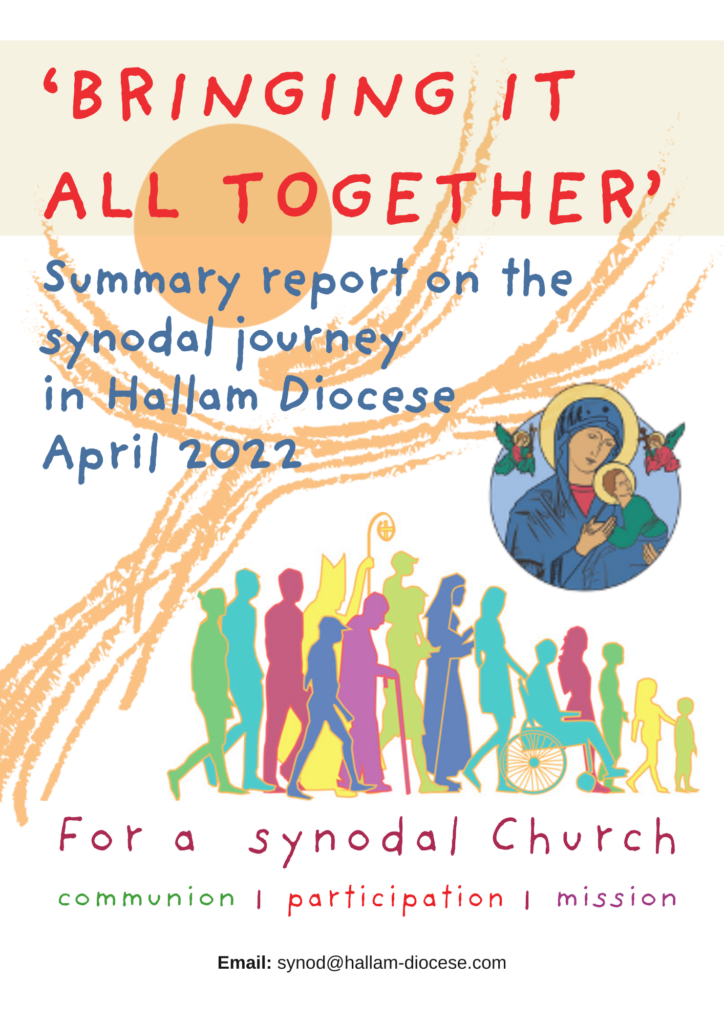
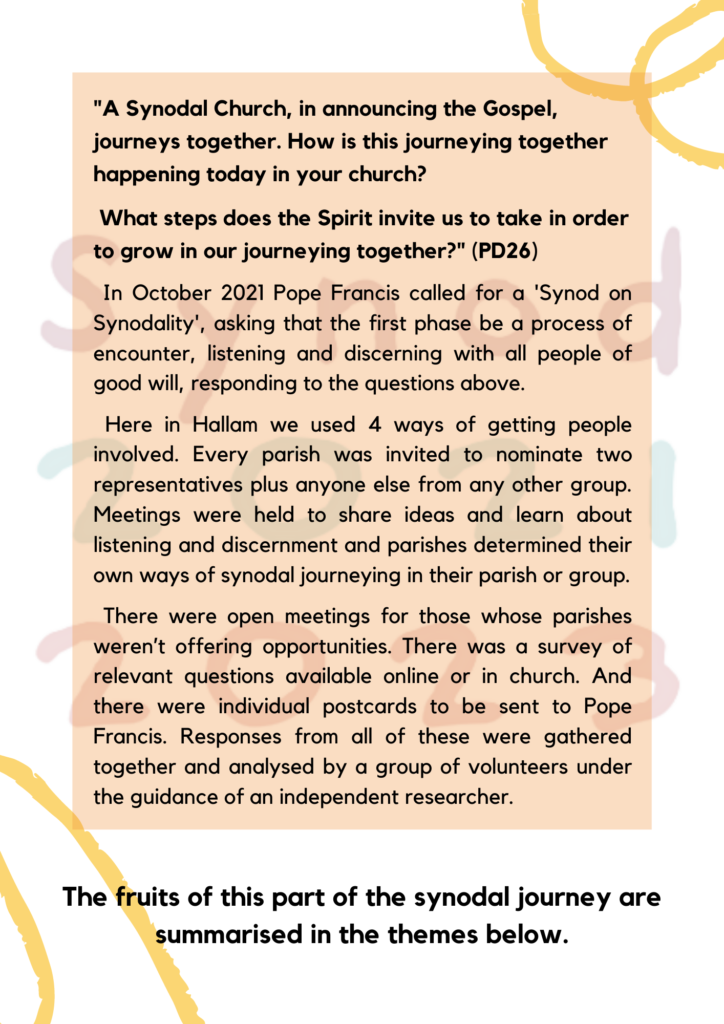
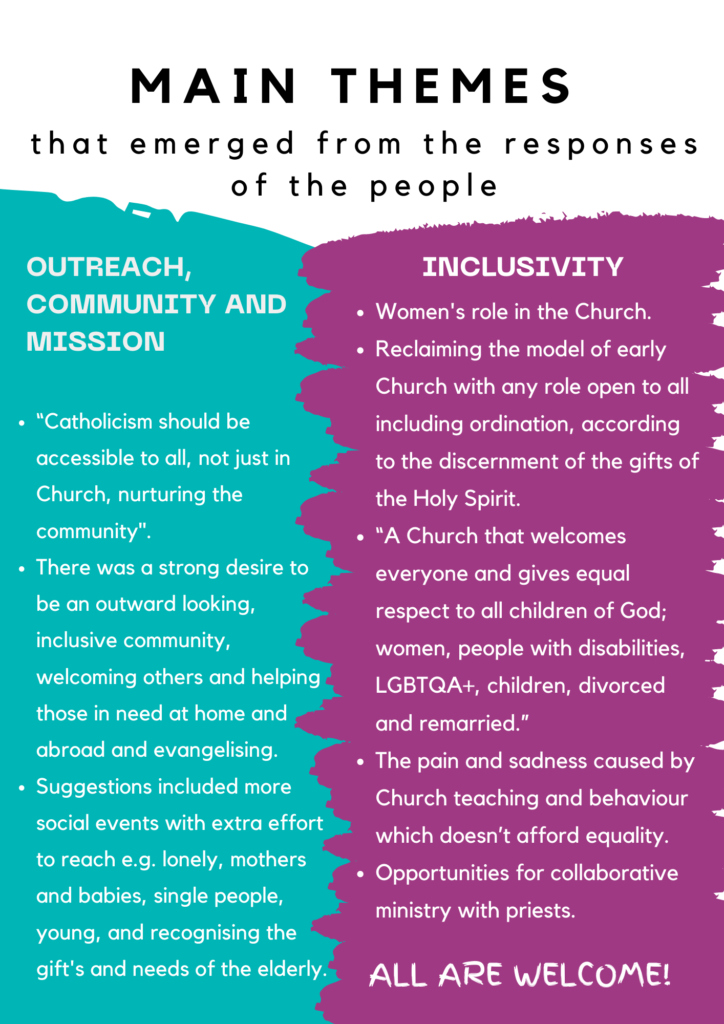
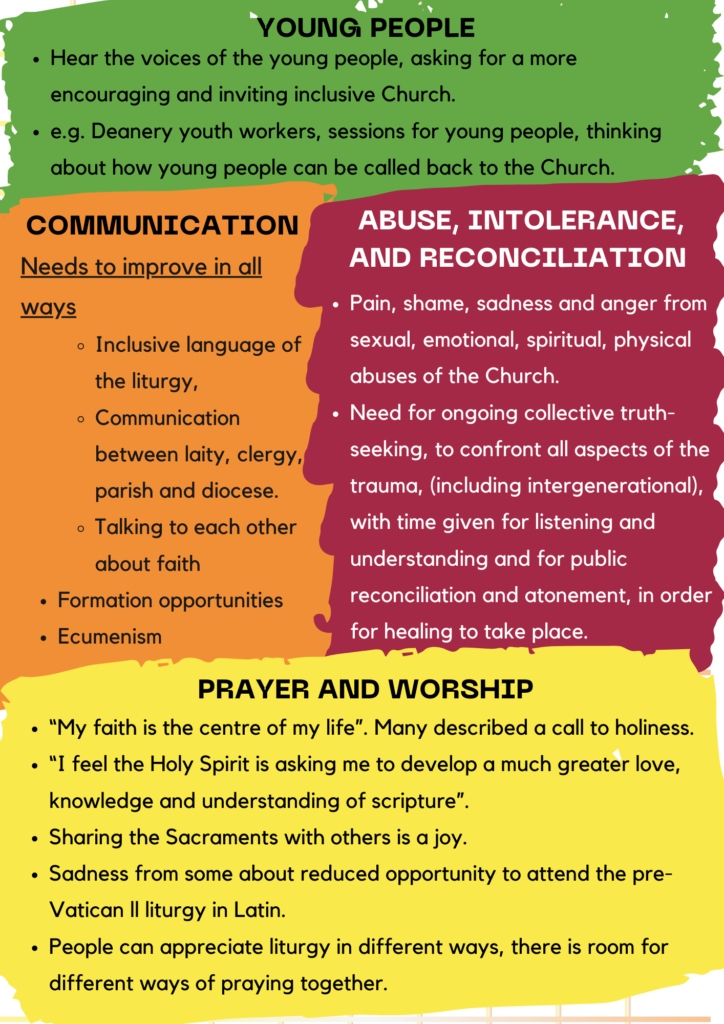
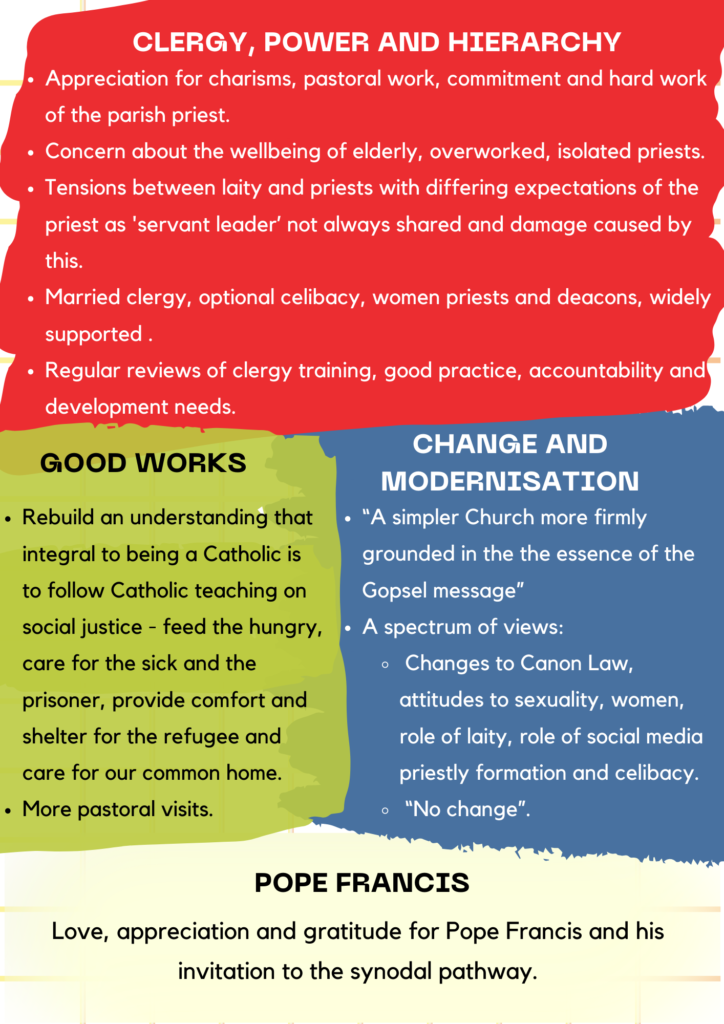

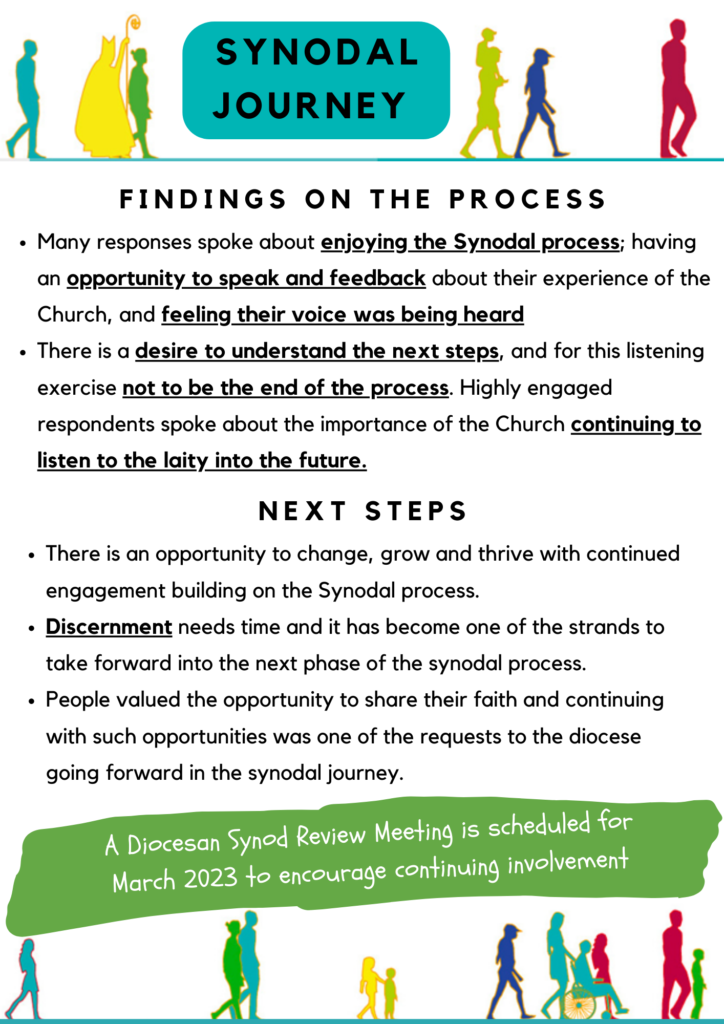
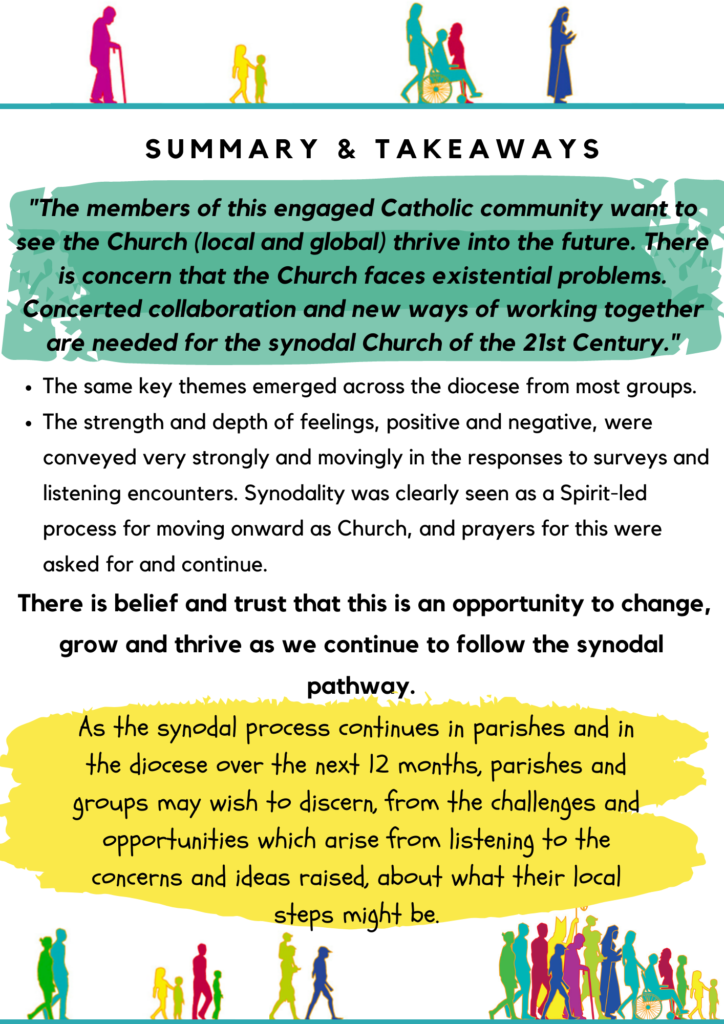
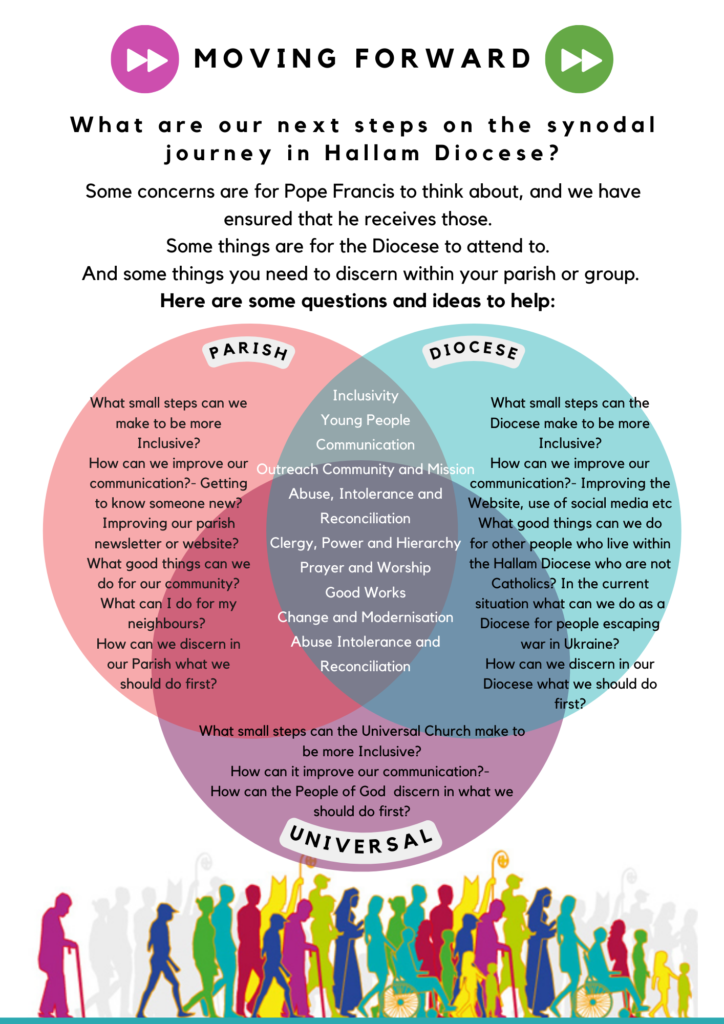
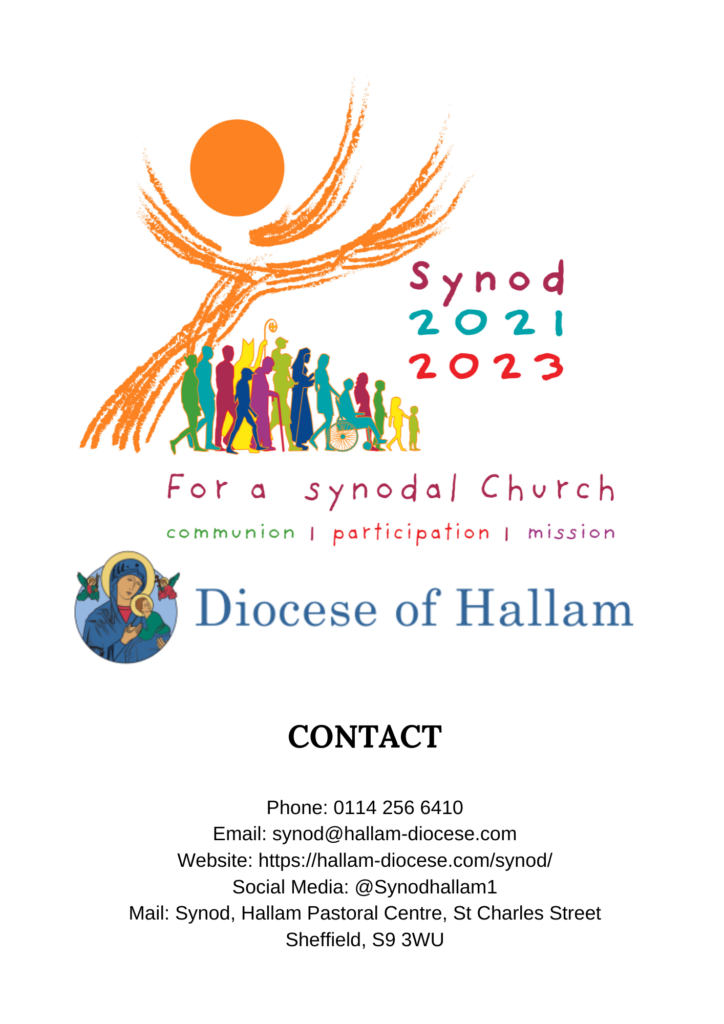
Synod Co-Ordinators in the Diocese of Hallam

Synod Co-Ordinators
Hallam Pastoral Centre
Sheffield
S9 3WU
0114 256 6410
